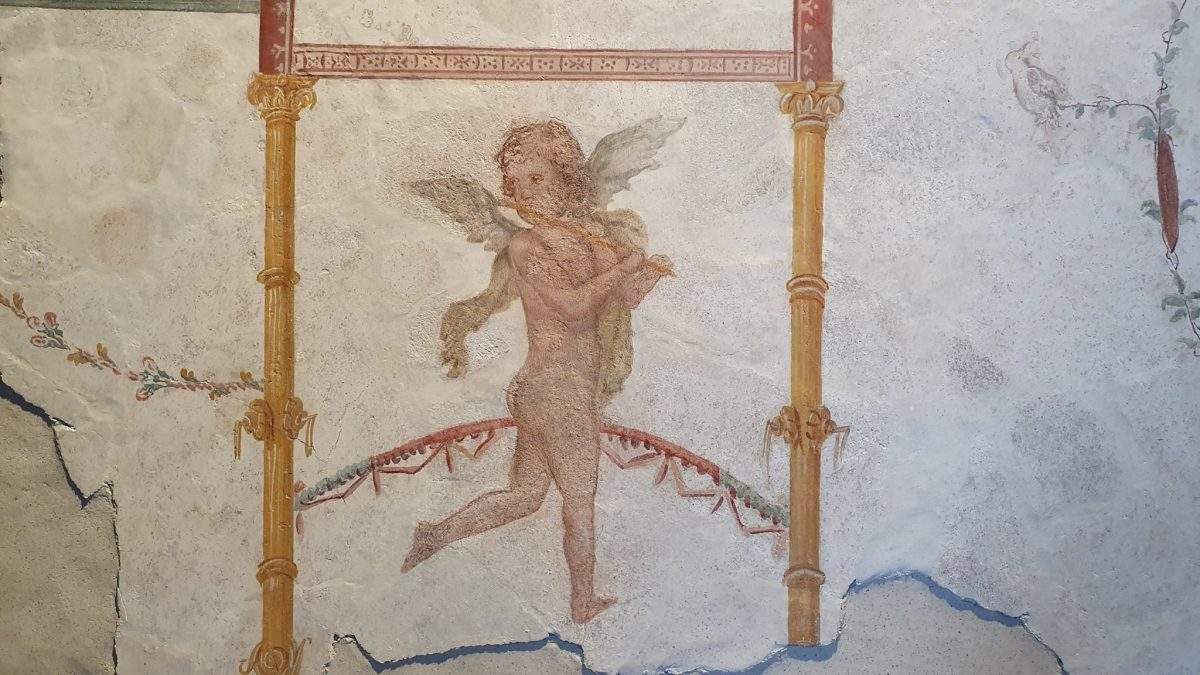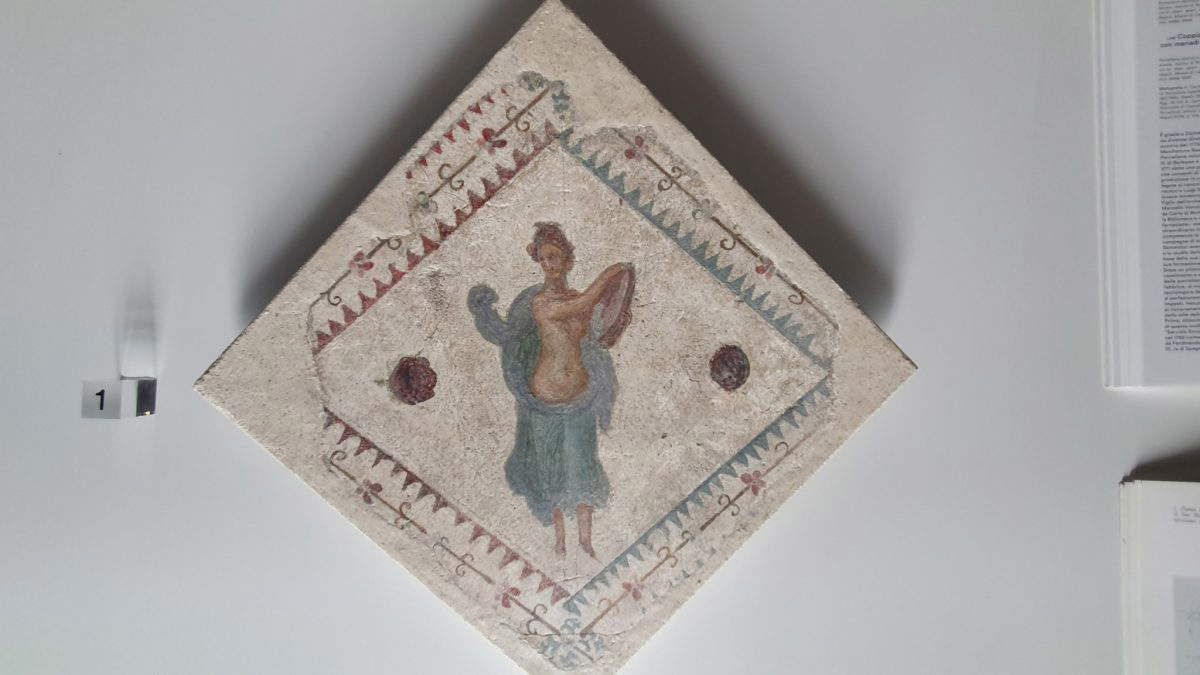Pompeii Archaeological Park is back in possession of six fresco fragments, datable to the 1st century AD, that had been stolen in the past. They are three fragments of wall frescoes from the 1st century AD from the Villas of Stabia and three fragments of frescoes removed from the suburban villa of Civita Giuliana (outside the walls of Pompeii), which were recovered thanks to the action of the Carabinieri Command for the Protection of Cultural Heritage. The fragments were returned to the Park on Tuesday in a ceremony attended by Massimo Osanna (Director General of Museums Ministry of Culture), Gabriel Zuchtriegel (Director General of the Archaeological Park of Pompeii), Gaetano Cimmino (Mayor of the City of Castellammare di Stabia), Laura Pedio (Deputy Prosecutor at the Court of Milan), Roberto Riccardi (Carabinieri Commander for the Protection of Cultural Heritage). Also present for the Park were the managers of the Reggia di Quisisana, Maria Rispoli, and the Ville di Stabia, Silvia Bertesago, and the head of the protection office, Anna Onesti, along with a representation for the Monza TPC Unit led by Lgt. Raffaele Adorante.
The investigations that led to these important recoveries were initiated by the Monza and Naples TPC Units in 2020 and 2012, respectively. The investigations made it possible to verify that the goods, which are not listed in the Database of Illicitly Misappropriated Cultural Property, the largest database of stolen works of art in the world, were allegedly stolen starting in the 1970s, illicitly exported and subsequently purchased in the 1990s from U.S., Swiss and British antique dealers. As for the three fragments from Stabia, through collaboration with Dr. Domenico Camardo, a technical advisor to the Torre Annunziata Public Prosecutor’s Office also regarding the Civita Giuliana excavations, and officials from the Archaeological Park of Pompeii, it was possible to establish that the frescoes came from the decorated walls of Villa Arianna and Villa San Marco in Stabiae, now Castellammare di Stabia. As early as the mid-eighteenth century, excavations of, among others, the villas were begun by the decision of Charles III, King of Naples. The most significant emerged frescoes were detached and properly preserved, and then placed in the National Archaeological Museum of Naples, where they are today. The villas were then buried and explored again in the 1950s and 1960s, on the initiative of Libero DOrsi, to whom the museum is dedicated today. The goods, whose authenticity and provenance were ascertained thanks to the cooperation of officials from the Pompeii Archaeological Park, were returned to the state on the order of Department VII of the Public Prosecutor’s Office at the Court of Milan, which directed the investigation.
“The return of these fragments is significant for several reasons,” says Massimo Osanna, Director General of Museums. “Meanwhile, an archaeological context that had been violated is recomposed in both cases, allowing the excavation to be restored to its completeness. Every find, constitutes an important piece of the history and knowledge of a place and should always be protected and preserved. But above all, it is a victory for legality, against the phenomenon of illegal excavations and trafficking in works of art and ancient artifacts, and a confirmation of the important role of law enforcement agencies in the protection of cultural heritage and the fundamental collaboration with the institutions of the Ministry of Culture.”
“The collaborations with the authorities in combating illegal excavations and illegal trafficking of archaeological artifacts initiated under the direction of Massimo Osanna are a best practice that the Park will follow in the future as well,” stresses Gabriel Zuchtriegel, Director of the Archaeological Park of Pompeii. “Through the enhancement of the sites in the area between Stabia, Torre Annunziata, Boscoreale and Poggiomarino we also want to contribute to bring out more and more of the limmenso value of the archaeological heritage present in a capillary manner throughout the Vesuvian area. Finds such as the Oscan lyscription from Porta Stabia, currently on display at the Scuderie del Quirinale in the Tota Italia exhibition, illustrate how the city of Pompeii was part of an ancient landscape made up of roads, villas, farms, necropolis and rural settlements that must be protected and enhanced. I thank on behalf of the Park the Procurators and the Carabinieri of the Protection Unit for their work.”
“Ancient works of great value are returning to their rightful place,” commented the Commander of the Carabinieri for the Protection of Cultural Heritage, Brigadier General Roberto Riccardi. “The Beauty that we are celebrating today is not only in the frescoes, it is also in the synergy between the representatives of the institutions present here, who worked feeling that they were children of the same history. The Culture we intend to enhance is also that of legality.”
 |
| Fragment of fresco with pavilion crowned with plant elements and double-pitched roof decorated with griffins; in the center of the pavilion naked cupid in the act of playing the transverse flute. Probable provenance from room 12 of Villa Arianna. |
 |
| Fragment of rhombus-shaped fresco with denticulated frame and vegetal scroll and with dancing female figure carrying a tray in the center. Probable provenance from room 9 of Villa Arianna, decorated with the same tile motif with female figures, cupids, birds and rosettes. |
 |
| Fragment of fresco with part of female figure on black background with crown of laurel leaves. Probable pertinence to the Stabian area by close comparison with a female figure with lyre in the Hermes fresco from Villa San Marco (on display at the Museo Libero DOrsi, inv. 62526). |
With regard to the Civita Giuliana frescoes, the investigations that led to the recovery of the three frescoes removed from the suburban archaeological area were initiated in July 2012, when military personnel from the Naples TPC Unit, as part of a complex investigation of a criminal organization dedicated to clandestine excavation and fencing of archaeological goods on national and foreign territory, found a hole covered by a layer of metal sheets, soil and crops, leading to one of the rooms of a Roman villa. The operations also led to the seizure of three fresco panels, which had been torn off and were the proceeds of illicit excavation activities, ready for export.
The area under investigation is currently undergoing an excavation campaign by the Pompeii Archaeological Park, at the request of the Public Prosecutor’s Office in Oplontina and in implementation of a protocol of understanding between it and the Archaeological Park: the excavations brought to light a series of service rooms and the residential part of a large suburban villa preserved in excellent condition, from which emerged finds of considerable scientific importance, such as the two fugitives, perhaps the master with his slave, victims of the eruption and identified in a side room of the cryptopothic, of which it was possible to make casts of extraordinary yield. Excavations made it possible for the first time to make a cast of a horse, and a ceremonial chariot with bronze trappings was also found.
Today’s return of fragments of frescoes from the Roman villas of Stabia and Civita Giuliana to the Directorate of the Archaeological Park of Pompeii is yet another tangible demonstration of the fruitful cooperation between said Directorate and the Judicial Authority," says Prosecutor Nunzio Fragliasso. “In recent years, the Torre Annunziata Public Prosecutor’s Office has always kept a high level of attention to the protection of the immense archaeological heritage present in the territory under its jurisdiction. In this context is the protocol signed in 2019 by this Prosecutor’s Office with the Archaeological Park of Pompeii, which represents a real pilot agreement in the field of synergy between institutions for the protection of the national artistic heritage and which has proved to be a formidable tool to return to the community relics and testimonies of exceptional historical and cultural value, countering the criminal action of individuals who for years have been the protagonists of a systematic looting of the priceless archaeological heritage kept in the area of the suburban villa of Civita Giuliana. The criminal trial before the Court of Torre Annunziata of the defendants held responsible for the depredation of the ancient Roman villa is still in progress. The commitment of this Office in the protection of the artistic, archaeological and cultural heritage of the territory will be constant and a priority in the coming years as well, with particular reference to the activity aimed at the recovery of valuable stolen archaeological finds, exported abroad, and their return to the national heritage.”
 |
| Pompeii, recovered six valuable fragments of frescoes stolen long ago |
Warning: the translation into English of the original Italian article was created using automatic tools. We undertake to review all articles, but we do not guarantee the total absence of inaccuracies in the translation due to the program. You can find the original by clicking on the ITA button. If you find any mistake,please contact us.